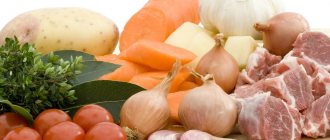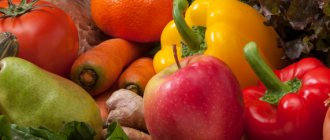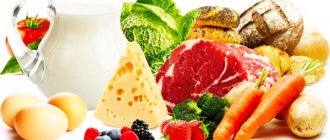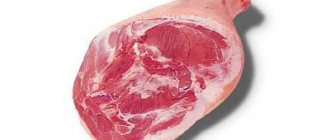The glycemic index (GI) of a product is determined by the rate at which it breaks down to form glucose in the body. Low GI foods break down more slowly. They gradually release glucose as they contain complex carbohydrates. The GI indicator is used by nutritionists to develop a proper nutrition system. It is based on replacing simple “fast” carbohydrates with “slow” ones and using low-calorie foods. This type of nutrition helps maintain a feeling of fullness for a longer period of time, while the body receives fewer calories than it expends, as a result the person loses weight. The concept of GI is closely related to the concept of insulin index (II).
Principles of carbohydrate metabolism
To understand why such indices are needed, you should understand the physiological processes that occur in the human body, because the indicators are associated with them. A person receives the required amount of energy in the process of carbohydrate metabolism. A simplified version says the following:
- When food enters the body, complex carbohydrates are broken down into simple saccharides, the representatives of which are glucose and fructose. Absorbed through the intestinal wall, they enter the bloodstream.
- In the blood, the level of glucose (sugar) rises sharply, and the pancreas receives a signal to release insulin (a hormonally active substance), the function of which is to transport sugar into cells and tissues and, accordingly, reduce blood levels.
- Insulin passes glucose to muscles and fat cells. Without the action of this hormone, tissues cannot let sugar in.
- Part of the monosaccharide is used to form energy resources, the rest is stored in tissues as a reserve in the form of glycogen.
Glycogen is necessary for the body to maintain optimal sugar levels in the period between meals and to restore blood glucose levels when it is significantly wasted due to physical activity.
If an insufficient amount of the hormone is produced by the pancreas, we are talking about the development of type 1 diabetes mellitus (insulin-dependent). With sufficient synthesis, but loss of cell sensitivity to insulin, type 2 pathology appears (insulin-independent).
Such patients adjust their diet, taking into account both the glycemic and insulin index of foods, since only with their help can laboratory parameters be kept within acceptable limits.
Scheme of the participation of the hormone insulin in metabolism
Medical standards for insulin
Any indicator has a certain scale of values by which one can judge the patient’s condition. If we say that insulin is a hormone of the pancreas, it is worth understanding that after each meal it can be increased. Therefore, there are some standards for taking tests. You must not eat 1.5 hours before or come for the study strictly on an empty stomach.
Then there is a high probability of a reliable result. The most basic thing that the doctor is trying to understand is whether the patient has diabetes, and if other problems arise, prescribe appropriate additional tests and medications. Let us immediately note that each medical laboratory or institution is able to indicate its individual values of the studied indicator, which will ultimately be considered normal.
In principle, the hormone insulin, the norm of which on an empty stomach will average 3-28 µU/ml, may also vary slightly. Therefore, when receiving analysis results, try not to panic, but rather visit a competent specialist to decipher them. For example, pregnant women have indicators that differ from other people (on average 6-28 µU/ml).
When a doctor suspects diabetes mellitus, it makes sense to already mention its two main types
:
- insulin hormone is low
– the pancreas does not cope with its job and produces it in insufficient quantities – type 1 diabetes;
- the hormone insulin is elevated
– the opposite situation, when there is a lot of the corresponding substance in the body, but it does not feel it and produces even more – type 2 diabetes.
Of course, an increase in this indicator will not always lead to diabetes mellitus.
One of the most common consequences can be obesity, and only then the disease of high blood sugar. Often, doctors and nutritionists, in order to explain to their patients the simple mechanism of excess weight formation, begin their story by answering a simple question: “Insulin is a hormone of which gland?” After all, people who eat large amounts of carbohydrate foods (for example, flour and sweet dishes) do not think about the load their pancreas experiences. Of course, you can eat these foods, but in moderate portions, then the whole system works organically.
We recommend
“Foods good for the kidneys: TOP-25 for good health” Read more
In general, with this diet, the following happens: insulin increases constantly (i.e., this process takes on a chronic form), but sugar enters the body in unlimited quantities, and as a result, it is simply stored in fat. And remember that in this case the appetite is greatly increased. A vicious circle, from which it will be very difficult for you to get out, is ensured: you eat a lot of unhealthy food and densely - insulin is increased - fat is deposited - appetite increases - again we eat in unlimited quantities.
What is the insulin index?
This figure is considered relatively young. It determines how much of the hormone insulin is released by the pancreas in response to the intake of a portion of carbohydrates in food. AI is not always proportional to another well-known indicator - the glycemic index.
It is known that not only saccharides, but also proteins and fats in large quantities can stimulate insulin synthesis. This happens even when the glycemic level does not require reduction. It is believed that it is bread that causes the greatest release of the hormone, although its glycemic index numbers are by no means the highest.
Products to normalize insulin levels
There are various foods that have a positive effect on the body, helping it restore normal insulin levels. Such products include
:
- Seafood and various types of fish
. It is these products that become a source of protein for the body and help restore lipid metabolism. Sea fish is rich in polyunsaturated fatty acids. It is recommended to eat salmon, trout, herring, mackerel, sardines and anchovies.
Numerous tests have confirmed the beneficial effects of fish on insulin levels. It has been proven that women who consume this product lowered their blood insulin levels by 8.4% more than the group that did not consume fish at all.
- Fiber-rich foods
. These include various types of vegetables, cereals, unsweetened fruits. When fiber enters the intestines, under the influence of various biological fluids, it swells and turns into a kind of mush, which can not only absorb various harmful components and toxins, but also regulate immunity.
- Green tea
. Of course, in limited quantities, no more than two cups per day. It is in this quantity that it is beneficial for the body and can influence the regulation of insulin levels in the blood. This happens due to the high content of antioxidants, as well as catechin. It provides a higher degree of cell sensitivity to insulin.
- Cinnamon
. You should choose real cinnamon, and not its substitute - cassia, which does nothing but harm the body. Natural cinnamon is the thinnest bark of a special brown tree that grows in the tropics and is supplied to the country from there. Cinnamon also contains many amino acids that help regulate insulin.
- Apple vinegar
. It is still not recommended to use it in its pure form, but it makes an excellent combination with other ingredients and belongs to the category of products that increase insulin sensitivity.
Difference between indexes
The glycemic index (GI) shows how much and how quickly sugar levels can increase in the bloodstream after receiving a portion of a particular product (possibly a dish). This indicator depends on the following points:
- activity of enzymatic reactions in the intestinal tract;
- growing conditions;
- product preparation technology;
- use of heat treatment;
- combination with other food products;
- storage conditions.
The use of heat treatment of a product affects its glycemic indicators.
Clinical studies have made it possible to calculate not only the increase in blood sugar after food intake, but also the time and amount of insulin that is necessary to return the numbers to their original state.
The level of AI is most important to take into account for insulin-dependent diabetics, since they need to correctly calculate the required dose of the drug.
During the same clinical studies, the ratio of GI and AI of the main products was determined for the purpose of comparing them. Scientists were perplexed when they found discrepancies in two numbers for the same product. For example, the GI of lactose turned out to be higher than its insulin values, which cannot be said about milk and dairy products. Their insulin index was several times higher than the glycemic index. For example, the GI of yogurt is 35, and its AI is 115.
Newspaper "News of Medicine and Pharmacy" 11-12 (371-372) 2011
The speed and intensity of the unwanted rapid increase in blood sugar depends on the presence and type of easily digestible carbohydrates in foods. But how to assess the presence and level of such carbohydrates in a food product? Indeed, in reference tables, and in the accompanying information on product packaging, only the total carbohydrate content is usually indicated. For the body, it is not at all indifferent to which products will satisfy the need for carbohydrates. For example, the same amount of carbohydrates can be obtained from both the corresponding portions of buckwheat porridge and honey. But the behavior of these products during digestion differs significantly. In the first case, carbohydrates are absorbed gradually; after eating, blood sugar rises relatively slowly, without causing peak hyperglycemia, without creating an excessive load on the pancreas and the need for large amounts of insulin. The situation is different in the case of a serving of honey (or other sugar-containing product), which will contain the same amount of carbohydrates as a serving of buckwheat porridge. The carbohydrates in honey are easily digestible; they are quickly absorbed and cause an unwanted rapid (peak) rise in blood glucose levels. That is why there was a need to have such an objective criterion that would allow the consumer to know how a particular product affects the rate of rise in blood glucose levels, how suitable this product is for people who must refrain from consuming easily digestible carbohydrates and avoid sharp postprandial (after taking food) hyperglycemia.
An indicator called the “glycemic index” (GI) has been proposed and is widely used as such a criterion. The value of this index indicates whether or not a given product has the ability to cause a rapid (peak) rise in blood glucose levels after its administration. It was agreed that the glycemic index (sometimes called the glycemic factor) of 100 g of glucose is equal to 100 conventional “glycemic” units, respectively, the same indicator of 1 g of glucose is equal to one.
The index value for a particular product was determined through special scientific research. They consist in the fact that the blood glucose level of the tested volunteers is determined every 15 minutes for 2 hours after eating a meal (product), the amount of carbohydrates in which is the same as in the reference dose of glucose (usually 50 g). The peak blood glucose level after taking the reference dose is taken as 100%. Similarly, peak blood glucose levels are determined after consuming various foods. So, for baked potatoes it turned out to be 85%, for pasta - 42%, for cabbage - 10%, for milk chocolate - 70%, honey - 85%, buckwheat porridge - 45%, etc. Similar indicators are used to assess the GI of other products. If the peak blood glucose level after taking this product was, for example, 60%, then the digital GI value for 100 g of this product will be the same, i.e. its GI will be 60.
To facilitate the preparation of a diet, we attach information on the glycemic index value of the most common foods containing carbohydrates (Table 1).
Do not be surprised if you find that in other similar tables the GI indicators of some foods will be slightly different than in the table. 1. Such a difference may be due to modifications of research methods, the nature of the culinary processing of the product, its origin, variety, etc. But usually the differences in GI values are insignificant and do not have significant practical significance.
The research results were reviewed and approved by many authoritative international and regional organizations. In particular, the World Health Organization (WHO), the Food and Agricultural Organization (FAO), the European Association for the Study of Diabetes (EASD), the Australian National Health and Medical Research Council (NHMRS) and others. According to their recommendations, the following criteria for evaluating food products according to the glycemic index and acceptable levels of consumption of these products have been adopted.
Products with a low glycemic index include those whose GI does not exceed 55, medium - with a GI from 56 to 69, foods with a high glycemic index are those whose GI exceeds 70 (remember that the GI of glucose is 100).
In particular, foods with a low glycemic index include: peas, oatmeal, rye bread, dairy products, wholemeal pasta, most fresh fruits, dark chocolate, natural fruit juice without added sugar, green vegetables, tomatoes, lemons, mushrooms, tangerines, grapefruit, broccoli, etc.
For the practical application of information about the glycemic index of certain products when compiling a nutrition menu, it is very important to understand another indicator associated with this index. We are talking about the so-called glycemic load (Glycemic Load - GL). This indicator allows us to judge the actual level of glycemic load when consuming a specific amount of carbohydrates in a serving of a particular dish and in the entire daily diet as a whole.
Let us explain the meaning of the glycemic load index and its calculation using the following example. Let's assume that we want to use 30 g of white rice to prepare a dish (porridge). What will be the actual carbohydrate load of this dish? Following simple arithmetic rules, we calculate that if the glycemic index of 100 g of white rice is 70, then the carbohydrate load (GL) when using 30 g will be 21 (30 ´ 70 : 100 = 21). The carbohydrate load of any other carbohydrate product is calculated in the same way. That is, we multiply the specific carbohydrate content in a serving intended for use by the glycemic index value of this product and divide the result of the multiplication by 100.
In dietetics, the following scale of glycemic load levels of individual portions (meals, dishes) of food is accepted: GL up to 10 is considered low, average - from 11 to 19, high - more than 20.
Knowing what the GI of the original products is and the glycemic load index of the actual diet, you can evaluate and adjust the overall level and tolerance of the glycemic load per day. The usual total daily food load on the glycemic index varies widely, on average between 60 and 180. A total glycemic load (GL) level of not exceeding 80 is considered low, average is from 81 to 119, high is 120 or more.
People who are overweight, have diabetes, as well as some other diseases and conditions that require a dietary diet that limits the amount of carbohydrates consumed should formulate their daily diet so that its total glycemic index does not exceed 80–100.
The essence of the GI diet is to, based on the above criteria and indicators and without disturbing the balance of the contents of all foods, to maximally replace carbohydrate foods that cause a rapid rise in blood sugar levels with those that have a low glycemic index. Those who adhere to such a diet maintain the recommended general biological nutritional value and at the same time create optimal metabolic conditions for the body, do not overload the hormonal apparatus, promote weight loss, prevent excess cholesterol formation, etc. This diet is becoming increasingly popular and in comparison with many other newfangled diets are rightfully considered by most experts to be the most physiological and effective.
Among many others, the glycemic index diet has gained wide popularity and practical application. Nutritionists, not without reason, characterize it as the most appropriate type of low-calorie, low-carbohydrate diet, which has many positive therapeutic and preventive properties. In connection with this diet, a relatively new indicator has recently been increasingly mentioned in the specialized and popular literature - the insulin index of food products (AI). How does it differ from glycemic, what are the needs and recommendations for its use?
It is well known that the intake and assimilation of food is accompanied by a rise in blood sugar (glucose) levels, the so-called postprandial glycemia. Rapid, peak glycemia is undesirable, because helps to weaken the function of the insulin-producing beta cells of the pancreas; the body (especially in diabetes mellitus) with a lack of insulin cannot fully absorb glucose and prevent the main danger of the disease - prolonged high levels of undigested glucose and its compounds in the blood. Since this danger is associated with the consumption of primarily carbohydrate-containing foods, it is very important to limit those that cause peak increases in glycemia. It turned out that even carbohydrate-containing products of the same weight and calorie content behave differently as stimulants of postprandial glycemia: some are capable of causing a rapid and higher level of glycemia, some are more moderate and smooth (i.e., safer for the body) glycemia. To quantify the differences in this property of foods, their glycemic index has been proposed and is widely used.
However, when assessing the biological and nutritional properties of various products, it is necessary to know not only the postprandial glycemia they cause, but also the load experienced by the body to produce (consume) the insulin necessary for the absorption of this product. Since 1997, scientific research has been carried out on this problem. A significant contribution to them also belongs to scientists from the Department of Biochemistry at the University of Sydney.
The purpose of one of the latest studies by these scientists (Am. J. Clin. Nutr. - 2009. - 90. - 986-992) was to compare postprandial insulinemia in response to a food load with an isoenergetic value of 240 kcal. The subjects were offered food that included 38 different foods (fruits, foods rich in carbohydrates and proteins, etc.). Primary studies were carried out by parallel determination of glycemic and insulin indices. Blood samples for analysis were taken every 15 minutes for 2 hours. White bread was used as the initial standard for comparison (its insulin index was taken as 100%). Studies have shown that after eating a carbohydrate meal, increases in blood sugar and insulin levels tended to be strongly correlated (pairwise correlation coefficients were 0.75 or higher).
Here are the comparative values of glycemic and insulin (in parentheses) indices of some food products and products: oatmeal - 60 (40), white flour pasta - 46 (40), white rice - 110 (79), brown rice - 104 (79 ), rye bread - 60 (56), white bread - 100 (100), potatoes - 141 (121), eggs - 42 (31), beef - 21 (51), fish - 28 (59), apples - 50 ( 59), oranges - 39 (60), bananas - 79 (81), grapes - 74 (82), ice cream - 70 (89), Mars bars - 79 (112), yogurt - 62 (115), milk - 30 (90), muesli - 60 (40), corn flakes - 76 (75).
From the above data it is clear that although in most cases there is a proportional relationship between the insulin and glycemic indices of foods (the higher the glycemic index, the higher the insulin index, and vice versa), such a dependence is not obligatory for all products. It has been found that foods rich in protein and containing carbohydrate fats have an insulin index (response) disproportionately higher than the glycemic index of these foods.
Interpretation of such a response is difficult. On the one hand, the positive thing is that increased insulin levels contribute to lower levels of postprandial glycemia. However, the downside is that to achieve this effect, the body will contribute to the depletion of pancreatic beta cells and the development of type 2 diabetes.
The disproportionate increase in AI has its own explanations. According to S. Holt and her co-authors, this is due to the fact that insulin helps digestion of food not only in terms of the absorption of carbohydrates. It is needed for amino acids in muscle cells involved in the process of carbohydrate absorption. Increased insulin is also needed because when protein foods are consumed, glucagon is released from the liver, which increases blood sugar levels. For healthy people this is not a problem. The picture is different in diabetes, when the physiological mechanism of compensation is disrupted and it is much more difficult for the body to compensate for glycemia, because he is also forced to cope with an additional carbohydrate load caused by the release of glucagon from the liver under the influence of protein foods.
According to the level of AI, food products are divided into three groups:
1) having high AI. These include bread, milk, yogurt, confectionery, potatoes, breakfast cereals;
2) products with a moderately high (average) level of AI - beef, fish;
3) products with low AI - eggs, buckwheat, oatmeal, muesli.
From the above, an important conclusion for dietetics follows: when consuming certain protein foods with a low glycemic index (for example, beef) to achieve relatively low glycemia, the insulin release may be disproportionately higher than when consuming most carbohydrate foods.
Knowledge of the insulin index of foods is of great importance when eating a mixed diet for people using an insulin pump, because allows you to more accurately predict the need for insulin. It is necessary to take into account not only the content of carbohydrates in food, but also their energy value. With the same carbohydrate content, the energy value of foods due to proteins and fats is higher, and this, in turn, determines the need for higher insulinemia.
It follows from this that only the glycemic index of foods does not always characterize the need for insulin necessary for their absorption and the load on its secretion by the beta cells of the pancreas. This observation has very important practical significance, because allows you to more correctly regulate insulin therapy for diabetes. In addition, foods with equal carbohydrate content do not necessarily stimulate insulin secretion to the same extent. For example, isoenergetic servings of pasta and potatoes contained ~50 g carbohydrates, but the GL for potatoes was three times that of pasta.
It is fair to note that one of the leading experts on the problem of the insulin index, D. Miller from the University of Sydney, points out that “although the insulin index looks promising, it should be emphasized that it will never replace the GI. And AI has the greatest promise in correcting glycemia for people with type 1 diabetes using pumps.”
Further research into this problem is needed, but today the glycemic index is undoubtedly the optimal criterion for predicting the glycemic load of foods on the body.
Application of indicators in practice
Important advice for people suffering from diabetes: when creating an individual menu, you should initially rely on glycemic index indicators, and only then adjust products to each other, taking into account the body’s insulin response to their consumption.
Complete neglect of AI is unacceptable, since foods with high numbers significantly deplete the pancreas, provoking the accumulation of lipids rather than using the existing reserve.
Principles for combining products according to their insulin index:
- Protein products (meat and fish, cottage cheese, nuts and mushrooms) should not be combined with starches (cereals, potatoes, peas and bread) and fast carbohydrates. They go well with fats (creamy and vegetable) and vegetables.
- Starches cannot be combined with fast carbohydrates (honey, fruit, jam, chocolate). Goes well with fats.
- Fast carbohydrates are not compatible with proteins, starches and vegetables. Goes well with fats.
- Vegetables do not go well with fast carbohydrates. Good when combined with proteins and fats.
Fish with vegetables is the optimal combination for patients with diabetes
. According to these principles, experts give diabetics the following recommendations:
- a ban on the consumption of easily digestible saccharides with fats, for example, meat dishes should not be washed down with sweetened drinks;
- the combination of proteins and carbohydrates should be limited to the maximum, for example, honey should not be added to cottage cheese;
- complex carbohydrates and unsaturated fats are the preferred combination (nuts and fish);
- During the cooking process, heat treatment should be used minimally (if possible);
- The breakfast menu should include protein products;
- in the evening, they prefer complex carbohydrates, since they promote the secretion of pancreatic hormone for a long time, but in small quantities.
There is no need to give preference to “dietary” products (meaning the labels on the packages), since precisely in order to achieve a “dietary” state, fats in the composition are replaced with carbohydrates.
The right products. Proper nutrition diet.
Recommendations from a nutritionist about the benefits and harms of food for the human body... https://www.youtube.com/watch?v=soTCx1BUPNc
Older people should not eat oatmeal and semolina... The glycemic index of semolina porridge is off the charts and there is no benefit from it.
Pearl barley porridge is a very healthy porridge for those who have bronchitis and inflammation of the bronchial system.
Oatmeal – Oatmeal contains a certain acid that blocks the absorption of calcium and promotes leaching of calcium from the bones. You can eat oatmeal only for 2 weeks, after which you take a 2-week break.
Fats that form the least amount of carcinogens when frying are a combination of melted lard and sunflower oil.
Flaxseed oil contains a lot of OMEGA-3 fatty acids. But it goes rancid very quickly, oxidizes in air and becomes a very toxic product.
Omega-6 is found in sunflower oil
Omega 9 is found in olive oil
Omega-3 is absorbed only in the presence of Omega-6 and Omega-9.
You need to buy oil for food - 1 extraction.
Refined oil is the lowest quality oil.
Butter is responsible for the production of unique substances in the body - prostaglandins. Which are responsible for the immune response. The number of immune cells depends on the substances prostaglandins, which are produced with the participation of butter.
Margarine is very harmful to the body and blood vessels, it causes atherosclerosis and clogs blood vessels.
Palm oil has replaced margarine...
Chicken egg - the white of the egg consists of pure protein - protein, and the yolk is made of fat - it contains ideal proportions of cholesterol and lecithin, which affects the formation of good and high-quality cholesterol in the body.
***
I will be glad to hear your comment. Subscribe to blog news and be the first to know.
Sincerely. Tatiana Kartavtseva
***
***
What the blog talks about:
- Our Health
- My gardening
- Tasty and fast
- My hobbies
- How I created the site
***
What you need to know about the insulin index?
It is impossible to independently determine the AI numbers of a particular product (special clinical and laboratory studies are carried out for this purpose). There are ready-made tables of insulin indexes.
Unfortunately, a complete table of indicators of the main products is not freely available, and those lists that can be found on the Internet contain a small number of “unfriendly” representatives, by the name of which you can already imagine which category they belong to.
Key points to remember:
- dairy products belong to the group with high AI numbers;
- the index of meat and fish dishes varies between 45-60 units;
- raw chicken eggs are classified as products with a low index – 31;
- low numbers are typical for vegetables (except potatoes), mushrooms;
- other product groups have similar indicators of the two indices;
- AI numbers for fruits and dark chocolate are 20-22.
Comparison of GI and AI indicators of some food products
How are indicators calculated?
The benchmark is 100%. As a basis, a professor from Australia took the insulin surge recorded after eating a piece of white bread with an energy value of 240 kcal. In the studies, servings of other foods also had their caloric content listed.
During testing, patients consumed one of the names, then, at intervals of 15 minutes, for two hours, doctors took blood samples to clarify the values of glucose and insulin in the blood. In most cases, products with a GI of 60 units or more also had AI indicators above average, but there were exceptions: fish, cottage cheese, meat, natural yogurt.
About the discrepancy between GI and AI of dairy products
Many diabetic patients and those people who are interested in losing excess weight are interested in the question of why the indicators of the two indices are so different for milk-based products. For example, the glycemic indicators of cottage cheese are at the level of 30 units, yogurt - 35, and the body's insulin response is 120 and 115, respectively.
Dairy products do not cause a significant increase in glycemic levels, but they stimulate the synthesis of insulin by the pancreas. The release of a significant amount of the hormone inactivates the work of a special enzyme that is involved in the process of lipid breakdown.
The result is the accumulation of fats in the body, no matter how strange it may sound (especially for those who thought that by eating cottage cheese, including “diet” cottage cheese, you could quickly lose weight). In addition, dairy products in large quantities can cause swelling, retaining fluid in the body. This occurs due to stimulation of the synthesis of adrenal hormones (particularly aldosterone) by insulin.
Important! There is no need to think that dairy products should not be consumed; on the contrary, this should be done due to the huge amount of useful substances in the composition, but in moderation.
Dairy products are vital products that require careful consumption
Insulin resistance, its symptoms and methods of correction
If the state of elevated insulin levels persists for a long time and is not corrected in any way, insulin resistance occurs. Insulin resistance
- this is the insensitivity of cells to insulin, the inability for cells, figuratively speaking, to take glucose for use. As a result, the pancreas produces even more insulin to help glucose enter the cell. And as long as it is able to produce enough insulin, your sugar levels will remain normal.
This is why in people with insulin resistance, sugar levels can remain normal for a long time. Insulin resistance is a risk factor for a variety of diseases and conditions, such as metabolic syndrome, fatty liver disease, type 2 diabetes, atherosclerosis, hypertension, polycystic ovary syndrome and others.
The problem is that insulin resistance may not manifest itself in any way and may exist even in people with a normal body mass index. However, there are still some risk factors, namely
:
- Overweight or obesity.
- Age 45 years and above, although this disease is rapidly becoming younger.
- Family history of type 2 diabetes.
- Passive lifestyle.
- Hypertension and elevated low-density cholesterol.
- History of gestational diabetes.
- Polycystic disease.
Insulin resistance does not manifest itself for a long time, but there are a number of symptoms that can make you pay attention to this problem
:
- Papillomas, especially their accumulation in the same places - often the neck.
- Hyperpigmentation in skin folds, known as acanthosis nigricans.
- Retinopathy.
- Hunger intolerance, drowsiness after eating.
- High blood pressure.
Targeted nutrition tips
that will increase your energy level by 10 out of 10
From TOP nutritionists of the MIIN
Get tips
To correct insulin resistance, changes in diet and lifestyle are used primarily. Nutrition certainly influences insulin resistance. Minimum measures we can take
:
- It is necessary to eliminate sugar, eating only complex carbohydrates and some simple carbohydrates from fruits and berries with less fructose.
- Limit consumption of dairy products due to their high insulin index.
- Reduce coffee and caffeinated drinks to 1-2 per day.
- Reduce the number of calories adequate to their consumption.
- Avoid snacking on foods that increase insulin levels in the blood.
Often, a keto or LCHF diet is used to restore insulin sensitivity. Its essence is to reduce carbohydrate intake to a minimum and high fat intake. This type of eating encourages the body to burn fat as its main source of fuel (not only the fat that a person consumes in his diet, but also that stored in his body).
The approximate distribution of BJU on the LCHF diet is as follows - 20/65/15%, while on the keto diet carbohydrates are limited to 5%.
Is an insulin surge scary?
An increase in the levels of hormonally active substances of the pancreas is an absolutely normal physiological reaction of the body. The numbers increase in the blood after receiving any food. It is impossible to completely eliminate hyperinsulinemia, since in this case disturbances in the body will occur.
Such hormonal surges occur up to 3-4 times a day, but abuse of easily digestible carbohydrates provokes a more frequent occurrence of such increases in numbers, and this is already bad for the normal course of metabolic processes.
General recommendations
To ensure that your diet is beneficial, follow the rules described below.
- Choose your food combination carefully. When eating carbohydrates, add saturated fat. For example, salmon avocado nuts.
- Avoid eating high GI foods (watermelon, baked goods, fried foods, yogurt).
- Do not eat fast carbohydrates and starchy foods after 14:00.
- Try to make the majority of your breakfast protein. Avoid cereal and milk or fruit juice, as this can cause a large insulin spike.
- Try not to consume dairy products in the afternoon.
- Eat complex carbohydrates and protein for dinner. The optimal combination would be chicken breast and buckwheat or bulgur.
- Read labels carefully before purchasing products. If they contain a sweetener (maltodextrin, malt, xylose, syrup, etc.), do not purchase them.
To reduce the insulin index of coffee and tea, consume them without sugar. If desired, add lemon or natural sweetener stevia to the drink.
Try not to lean on the dried apricots. Dried fruits have a concentrated sugar content, which causes a sharp rise in blood glucose levels. Replace dried fruits with fresh, low-GI foods such as pomegranate, apples or grapefruit.
On the one hand, it seems clear: the glycemic index shows the degree of saturation of the blood with sugar, and the insulin index shows the rate of nisulin production for the quality absorption of food. However, although the table is a convenient tool in diet planning, you should also understand the rules for consuming foods with different AIs.
A complex approach
Important points:
- both indices are significant only in combination with the so-called “insulin response”;
- a combination of different food names can lead to a very unexpected result;
- This means that when compiling rations, menus and diets, not only product indices should be taken into account, but also the body’s personal perception, food ensemble, lifestyle (physically active, inactive, stress, nervous tension, age, etc.).
Sometimes people, when playing sports, unwittingly drive themselves into hypoglycemia (too low sugar levels). How does this happen:
- take fast proteins - milk and whey;
- a lot of insulin is released into the blood;
- an insulin surge leads to a sharp drop in sugar levels;
- a person feels weak and really wants to eat something (something filling, nutritious);
- obeying an uncontrollable feeling of hunger, a person begins to absorb new food (this behavior is dictated by the body, which requires restoration of sugar levels);
- The result is excess weight gain.
How to use the index to gain and lose weight
If a person has a goal to reduce their body weight, then it is better to include products that have high AI indicators in an individual menu so that they are consumed in the first half of the day. After 14-00 it is already important to keep hormone levels within strict limits.
If the goal, on the contrary, is weight gain, foods with significant AI indicators should be distributed as follows: 2 meals should be before lunch, the third after lunch.
An endocrinologist or nutritionist will help a diabetic understand what AI is, why it is needed, and how to use tabular indicators of products to create a menu. With the help of individual recommendations, the patient will be able to adjust the future diet independently.
Products with a high AI score in the table
A high AI score is considered to be greater than 81.
Table 1: Foods with a high insulin index
| Name of food product | Insulin index | Name of food product | Insulin index |
| Chocolate bar | 122 | Milk | 90 |
| Grape | 82 | Ice cream | 89 |
| Melon | 95 | Shortbread cookies | 92 |
| Yogurt | 115 | Cake | 82 |
| Fermented milk products (kefir, fermented baked milk) | 98 | Stewed beans | 120 |
| Caramel | 160 | Crackers | 87 |
| Boiled potatoes | 121 | Sour cream | 98 |
| Cupcakes | 82 | Dates | 110 |
| Candies | 120 | Cottage cheese | 120 |
| Crackers | 87 | Cake | 82 |
| Dried fruits | 110 | Black bread | 96 |
Mechanism of carbohydrate breakdown and glucose absorption
Diagram showing how glucose enters a muscle cell
It has been clinically proven that a person who understands how and why the disease developed, as well as how a particular treatment method specifically affects the body, is more responsible in the treatment process, recovers faster, and does everything necessary to ensure that the disease does not return. .
Here's how carbohydrates are metabolized:
- during the process of absorption, simple sugars quickly and independently break down into glucose, immediately entering the bloodstream;
- complex sugars require fermentation time to break down into glucose;
- an increase in glucose content and/or activation of the fermentation processes of complex carbohydrates has a stimulating effect on the beta cells of the pancreas, and they begin to produce the insulin hormone;
- For the absorption of glucose, the insulin hormone is necessary because insulin cells are a kind of “key” that opens special channels in the membranes of muscle cells through which glucose penetrates inside (see figure above).
In a healthy person, to maintain normal life functions, the necessary part of glucose quickly “burns out”, and its excess is distributed to replenish glycogen:
- Muscle glycogen is used up in emergencies for the body - during times of stress, it is used to achieve peak physical performance. Glycogen from skeletal muscle also provides physical endurance. Thanks to it, a person can perform physical movements for a fairly long period of time without food.
- Glycogen stores from the liver are used up between meals and during the night's rest. It ensures a constant level of glucose in the bloodstream at 5 mmol/l.
In people with type 1 diabetes, the disease is caused by the destruction of the beta cells that produce insulin in the pancreas. Therefore, little of it is produced, and some of the glucose is not utilized at all.
In type 2 diabetics, the insulin hormone is produced in sufficient quantities, but the muscle cell membranes do not respond to insulin, so glucose is utilized in fat cells.
It is logical that for diabetics of any form of pathology, obese patients, athletes, people leading a healthy lifestyle and striving to maintain the principles of a healthy diet, it is important to know:
- how quickly certain complex carbohydrates are fermented;
- what amount of insulin is needed to utilize glucose in muscle cells at the proper level;
- what physical activity is necessary so that the muscle cells can “see” the insulin hormone and absorb glucose from the blood;
- how to calculate the required dose for injection in case of insufficient synthesis of your own insulin;
- How many carbohydrates can you eat per day without causing an attack of hyperglycemia?
In the 20th and early 21st centuries, doctors gradually helped solve all these issues by studying the “behavior” of carbohydrates and the absorption of glucose. Research on these topics is still being carried out.
Yogurt is doubly healthy if combined with cucumber
Eating foods that do not provoke a surge in blood sugar levels and the release of insulin is considered reliable insurance against the occurrence of insulin resistance syndrome. This metabolic disorder occurs when tissues lose sensitivity to the hormone. The consequences are bleak: obesity and a whole bunch of diseases.
An unexpected way out of this dilemma was found by Swedish researchers Elin Yustman, Helena Liljeberg Elmsthal and Inger Bürk. They published the results of a study in the American Journal of Clinical Nutrition in which 10 volunteers took part. Scientists have found that although yogurt and other products made from fermented (fermented) milk have a high insulinemic index, when combined with another source of organic acids (pickled cucumbers played this role in the experiment), they reduce the rate of insulin release even if together with They eat white bread, this example of absolute insulin evil. Whole milk and fresh cucumbers, which is typical, did not have such an effect (no matter how ironic this food tandem may look).
The good, the bad, the treacherous
It will be interesting to know that some popular products in the hands of researchers, on the contrary, have demonstrated that they have virtually no effect on the speed and volume of insulin production. This means that dishes made from them can keep you full for a long time! Here is this nice list:
- Olive oil - AI = 3
- Avocado - AI = 5
- Walnuts - AI = 6
- Tuna - AI = 16
- Chicken - AI = 20
The opposite is foods with the maximum insulinemic index. Their listing will come as a surprise to those who have studied the topic of the glycemic index. The record holders for AI are the same simple carbohydrates and sources of starch:
- Jelly Candies - AI = 120
- Pancakes and pancakes made from white flour - AI = 112
- Melon - AI = 95
- Potatoes - AI = 90
- Breakfast cereal - AI = 70-113 (depending on composition, additives and sweeteners used in production)
Finally, two sneaky foods have an unexpectedly high insulinemic index compared to a relatively low glycemic index. These are yogurt (its GI is from 35 to 63 depending on the composition, and AI is 90-115!) and oranges (with a low GI of no more than 40, their AI rises to 60-70). If everything is more or less clear with oranges, then scientists have not yet agreed why yogurt makes insulin “jump” so seriously - apparently, it’s a combination of galactose and proteins in the composition.
What to do: remember the synergistic effect
Insulin-raising yogurt with the addition of fruits and other products with simple sugars is not an important combination if you are watching your health and figure. And yogurt with orange turns out to be a test of pancreatic strength! But now you have another reason to add healthy fats (nuts, butter and avocado) and chicken and tuna to your menu - you may have already noticed that these foods make you forget about hunger, but now you know that it's not just about your stomach , but also in hormones











